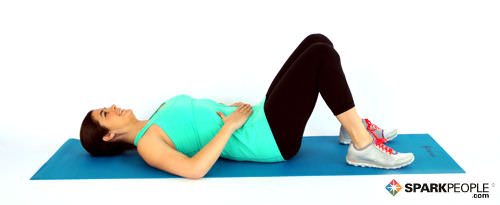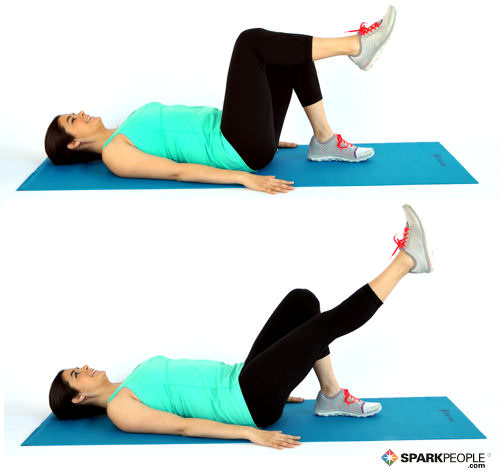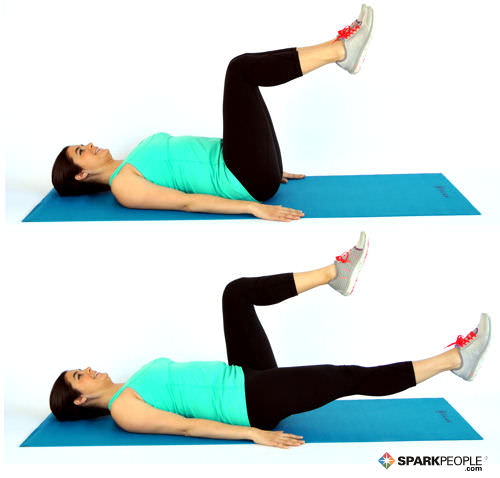After pregnancy, you're probably eager to get your post-baby body back in shape. But before you jump back into your usual abs workouts, there are some special considerations that new moms need to take into account.
Some postpartum women may notice a soft section above and below their belly button that can be felt when they contract their abdominal muscles. This soft area developed during pregnancy: As your belly expanded, the connective tissue that joins the two sides of the rectus abdominis muscle thinned and widened creating a larger, softer gap. The separation, termed a "diastasis recti" is a normal process of pregnancy and allows the belly to expand and make room for the growing baby. But it can remain present after delivery—and needs special care to rehabilitate.
Not all abs exercises are suitable for postpartum moms. Traditional abdominal exercises, such as sit-ups and crunches, put too much stress on a postpartum tummy and back, and are not recommended for new moms. The exercises below are the best place to start. These moves effectively target the weakened abdominal muscles and allow for a gentle, slow progression that can help resolve diastasis recti.
These postpartum abdominal exercises are part of a five-step progressive workout plan. Developed by Shirley Sahrmann, a physical therapist who specializes in abdominal rehabilitation, this series was designed to target the areas most weakened by pregnancy (below the belly button) without creating stress on the back or abdomen. They're amazingly effective, but it is important for you to go slowly and master each exercise (maintaining the form described and achieving the number of reps listed) before moving on to the next one.
When to Resume Core Exercises
Before you do any abdominal exercises, consult with your doctor to make sure your body is fully recovered from delivery and any incisions are fully healed. After being cleared by your doctor, a Cesarean mom can start these exercises once her incisions have healed (stitches are dissolved or taken out) and she doesn't feel pain when contracting her tummy. If you had a vaginal birth you can get started (with your doctor's approval) once any incisions or tears have healed.
Level 1: Basic Breath
Lie on your back with your arms at your sides, knees bent, feet resting on the floor. Inhale and exhale a few times. Don't flatten your back or tilt your pelvis—just let the natural curve in your spine remain. Breathe in slowly and deeply. Now, breathe out and tighten your tummy muscles, pulling your navel towards your spine (without flattening or changing the position of your lower back) and hold the contraction for five seconds. Keep breathing as you hold and try and work up to five to 10 of these contractions several times a day.
Concentrate on contracting the muscles below your belly button during each exhale. When you are able to contract and relax your abdominal muscles without moving your back or spine position, you have learned to properly isolate the correct muscles. You can then move on to the next level.
Level 2: Single-Leg Heel Slides
Lie on the floor with knees bent and arms at your sides. Hold your tummy in by doing your basic breath contraction (Level 1 exercise). Keeping one leg stationary, slowly slide the opposite leg out until it is straight along floor, then slide it back into the starting position. Alternate sides, extending the other leg out and then back in to complete one rep.
Remember not to flatten your back and to keep the curve of your spine relaxed. When your abdominal muscles are contracted, it helps to stabilize your pelvis while your legs and lower tummy muscles work. This prevents strain in your back muscles, and trains your abdominal muscles to protect and support your spine. When you can comfortably do 20 heel slides on each side you are ready to move on to the next level.
Level 3: Basic Single-Leg Extensions
Lie on floor with knees bent and arms at your sides. Hold your tummy in by doing your basic breath contraction (Level 1 exercise), then raise one leg to table top position (knees bent and in line with hip, shin parallel to the floor). Slowly extend the lifted leg out as close to the floor as you can without your back arching. Return leg to table top position, then bring foot back down to the starting position. Switch sides.
Progress with this until you can extend the leg out and hover it about two to three inches above the floor (without touching it). Work up to five repetitions on each side without stopping, building to 20 "hovering" repetitions or more on each side—without allowing your back or spine to move at all—before moving to the next level. <pagebreak>
Level 4: Single-Leg Toe Taps
Lie on the floor with knees bent and arms at your sides. Hold your tummy in by doing your basic breath contraction (Level 1 exercise) as you bring your legs up one at a time to table top position (knees bent and over hips, shins parallel to the floor). Keep one leg stationary as you slowly lower the other foot down to the floor (keeping knee bent) and back up to tabletop. Your lower back and spine should not move at all throughout this movement. Repeat on the opposite side, working up to 10 controlled repetitions on each leg before moving on to the next level.
Level 5: Advanced Single-Leg Extensions
Lie on the floor with knees bent and arms at your sides. Hold your tummy in by doing your basic breath contraction (Level 1 exercise) as you bring your legs up one at a time to table top position (knees bent and over hips, shins parallel to the floor). Keeping one leg stationary, slowly extend the opposite leg out, parallel with the floor but not touching it. Return the leg to the starting position and switch to the opposite leg.
With each repetition remember to breathe, contract your tummy as you move, and keep your back neutral (not moving, flattening or arching up). If the arch in your back keeps popping up during the exercise, then you're not strong enough to progress to this level, and need to go back to the previous exercise until you build greater strength. Work up to 10 repetitions each leg to start. When you can repeat this exercise 20 times on each leg without discomfort or arching your back, move on to the final level.
Level 6: Double Leg Lowers
Lie on the floor with knees bent and arms at your sides. Hold your tummy in by doing your basic breath contraction (Level 1 exercise) as you bring your legs up one at a time to table top position (knees bent and over hips, shins parallel to the floor). Squeezing your legs together, extend your legs up in line with your hips. Slowly lower both down toward the floor as far as you comfortably can without your back arching, flattening or moving at all, then contract your abs to return your legs to the line of the hips to complete one repetition.
If you feel your back beginning to arch, bring your legs back up and lower legs again, only as far as you can without arching the back. Work up to 20 repetitions. If you notice back pain with this exercise, return to the previous level.
|













